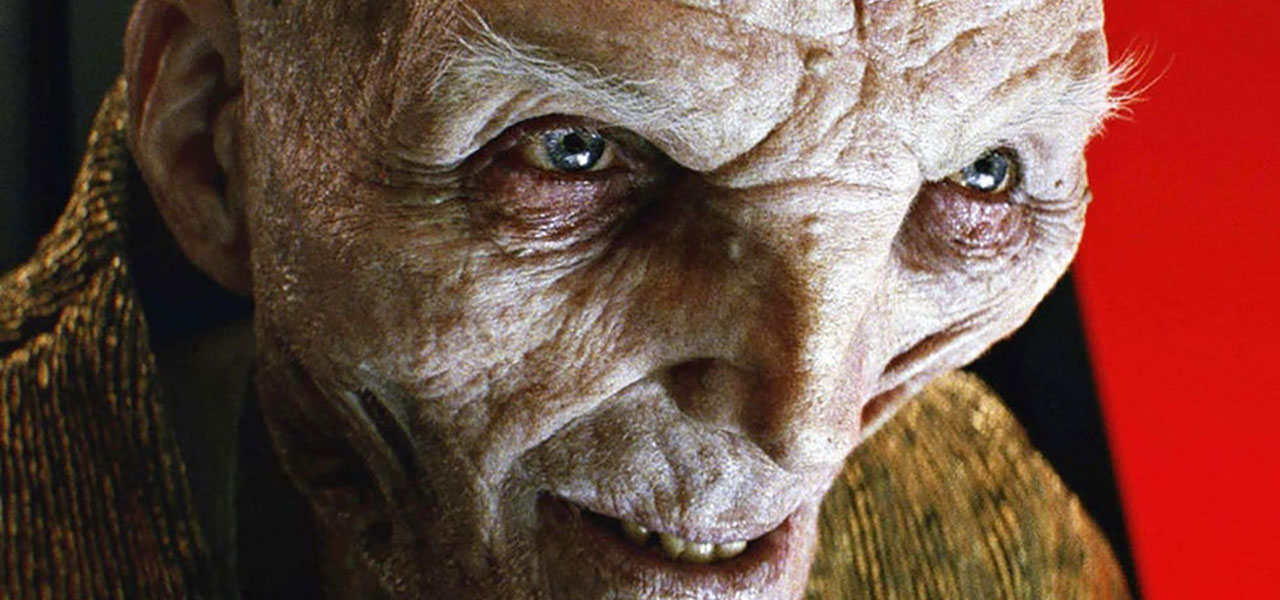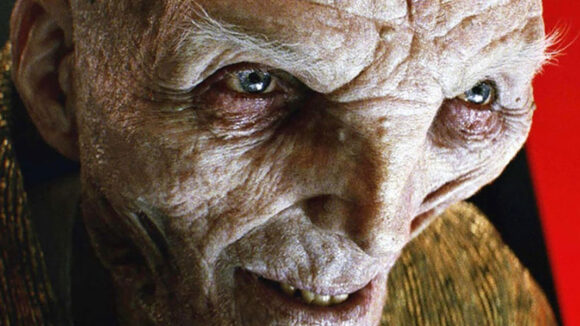

The Evolution of Snoke In ‘The Last Jedi’: From Andy Serkis To Animation
Industrial Light & Magic is no stranger to realizing complex cg characters, and Supreme Leader Snoke in Rian Johnson’s The Last Jedi – played by Andy Serkis – was one that they had actually tackled previously in The Force Awakens, although there he appeared as only a projected hologram.
In this latest film, Snoke is seen in the cg-flesh, and that meant a brand new set of challenges for ILM. In addition, after the motion capture shoot with Serkis was completed and shot production had begun, Johnson and ILM saw that the character needed some slight readjustments to ensure he came across with just the right kind of menace.
Cartoon Brew found out more from ILM after sitting down with members of the team in their London studio to discuss h ow the Snoke scenes were filmed and how the character evolved.
Re-visiting Snoke
Snoke’s appearance in The Last Jedi is relatively short-lived: after taunting Rey (Daisy Ridley) in his throne room aboard a ship, Snoke ultimately meets his doom at the hands of his own apprentice, Kylo Ren (Adam Driver).
The first thing done in relation to Snoke on the film was to re-work a marble-like maquette originally made for The Force Awakens. “The brief from Rian was to make it a more physically-present character,” explained ILM visual effects supervisor Mike Mulholland, who oversaw the work out of ILM London (Ben Morris was the film’s overall visual effects supervisor, also based in London). “It had to be made of skin. So they did a whole new sculpt, refined it slightly, made it kind of a skin-textured latex model. This was a model, which would act as a reference on set.”

During the shoot, a body double six-and-a-half feet tall stood in for the cg Snoke dressed in his distinctive golden robe. Another double, who was cast for age, was also on set for reference. Then Andy Serkis performed the scene in a motion capture set-up that involved a tracking marker suit, tracking markers on his face, and a head camera rig. This utilized up to four head mounted cameras, but occasionally if he was getting close to another character, such as Rey, the cameras would not be worn.
“That data capture took us down two roads, which ran parallel to each other,” said Mulholland. “One is the body performance so we take that and recreate that into cg. We’d start off with a virtual version of Andy performing as Andy was performing on the day. The problem with the virtual version of Andy is that it’s Andy’s scale, it’s not Snoke’s scale. So there’s a period of retargeting where we’re taking Andy’s skeleton and moving it onto Snoke’s skeleton and then having to look at it and adjusting it, so you get the correct posture and eye lines and sense of speed for Snoke. There’s a fair amount of editing, which happens post the capture process, just to kind of tie the character together and account for any adjustments.”
New character considerations
As ILM began piecing together the scenes and showing early animation to Rian Johnson, the filmmakers realized that the character needed some refinement. “We had done a whole new build of the head based on the maquette used on set and we started putting it into the pipeline,” said Mulholland. “An interesting thing we found was that when we started showing it to Rian, there was a gulf between that design and Andy’s performance. Andy has got a very powerful voice. It’s a very deep, very scary voice, and the model we were working with just felt a little bit too old and feeble. There wasn’t enough menace in the character design at that point.”

One part of the solution was to adjust Snoke’s facial structure. Modelers gave the character a wider-set jaw and altered the brows and some other aspects of the face. “It was a lot of little subtle things,” said Mulholland, “but enough to add up to actually give you much more of a sense of menace from his character, so that gave him a stronger physical presence.”
Serkis had also performed the character in motion capture factoring in some of these more feeble physical traits. “He’d been more twisted, physically,” said ILM animation supervisor Steve Aplin, “in that his body felt like he had scoliosis through his spine. He looked very weak.” The filmmakers wanted to bring in more of a powerful feel to the character, and so straightened Snoke up somewhat and untwisted him.
“There were still some moments when Rian would pull us back to Andy’s movements, especially when we got up to the facial performance,” explained Aplin. “He’d say, ‘There’s something Andy did, which we’ve lost in this moment,’ and it could be the simplest, smallest thing. And all of our animators had to pay attention very strongly to this. There were certain lines which might change, which we had to re-animate, but there was something which Andy had been going for underneath the surface which we really wanted to maintain.”

Animating evil, but pleasant
A major challenge for ILM also lay in working in a simmering rage to Snoke, even though during the main throne room sequence he is quite cordial at times with Kylo and Rey. “Snoke is almost like a pleasant uncle,” said Aplin. “It’s like, ‘So, come in Rey, come and sit by the fire.’ But then, as he continues to talk, we really had to work, especially when we got into the close-ups of his micro expressions, which told another story – that he’s simmering under there, there’s a rage going on.”
The process involved a significant amount of subtle keyframe animation, with Serkis’ original motion capture performance as the starting point. “When you get motion capture footage, facial footage, it can work incredibly well when you’ve got a character, which is physiologically very similar to a human, a like for like almost,” said Aplin. “But with Andy’s face, which was super expressive, and far fleshier than our character design, which was very much skin and bone and scar tissue, we had to reverse engineer this, because everything was moving too much on this very tight-skinned face, where everything kind of pulled and stretched.”
“What we’re trying to do is get a version of Andy existing in cg,” added Mulholland, “and once that process is complete, we’ll end up with a mask of Andy which matches exactly what he was doing, which we need to take and we will move it onto Snoke. We have a direct relationship between Andy’s face and Snoke’s face. Key features, eyes, nose, mouth and also key lines on the face are set up so they match.”

During the process of making the scene, the state of Johnson’s throne room edit for several months featured only footage of Serkis, until the cg character was gradually implemented. It meant, said Mulholland, that the director was “super-attuned to what Andy was doing, Andy’s performance, the subtleties.”
“A goal of mine, then, was to make sure that everything Andy did, every subtle nuance was transmitted onto Snoke,” added Mulholland. “That was always the test – it was, when would Rian stop calling back to Andy’s performance, and when would he just go, ‘That’s it,’ that’s the performance he’s used to.”
